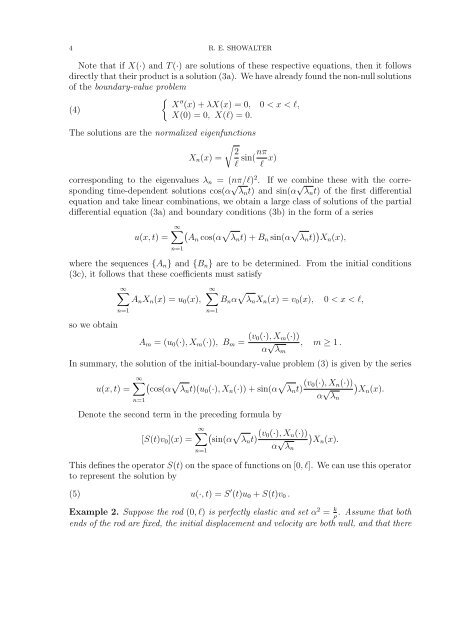THE WAVE EQUATION 1. Longitudinal Vibrations We describe the ...
THE WAVE EQUATION 1. Longitudinal Vibrations We describe the ...
THE WAVE EQUATION 1. Longitudinal Vibrations We describe the ...
You also want an ePaper? Increase the reach of your titles
YUMPU automatically turns print PDFs into web optimized ePapers that Google loves.
4 R. E. SHOWALTERNote that if X(·) and T (·) are solutions of <strong>the</strong>se respective equations, <strong>the</strong>n it followsdirectly that <strong>the</strong>ir product is a solution (3a). <strong>We</strong> have already found <strong>the</strong> non-null solutionsof <strong>the</strong> boundary-value problem{X ′′ (x) + λX(x) = 0, 0 < x < l,(4)X(0) = 0, X(l) = 0.The solutions are <strong>the</strong> normalized eigenfunctionsX n (x) =√2l sin(nπ l x)corresponding to <strong>the</strong> eigenvalues λ n = (nπ/l) 2 . If we combine <strong>the</strong>se with <strong>the</strong> correspondingtime-dependent solutions cos(α √ λ n t) and sin(α √ λ n t) of <strong>the</strong> first differentialequation and take linear combinations, we obtain a large class of solutions of <strong>the</strong> partialdifferential equation (3a) and boundary conditions (3b) in <strong>the</strong> form of a seriesu(x, t) =∞∑ (An cos(α √ λ n t) + B n sin(α √ λ n t) ) X n (x),n=1where <strong>the</strong> sequences {A n } and {B n } are to be determined. From <strong>the</strong> initial conditions(3c), it follows that <strong>the</strong>se coefficients must satisfyso we obtain∞∑A n X n (x) = u 0 (x),n=1∞∑B n α √ λ n X n (x) = v 0 (x), 0 < x < l,n=1A m = (u 0 (·), X m (·)), B m = (v 0(·), X m (·))α √ λ m, m ≥ 1 .In summary, <strong>the</strong> solution of <strong>the</strong> initial-boundary-value problem (3) is given by <strong>the</strong> seriesu(x, t) =∞∑ ( √cos(α λn t)(u 0 (·), X n (·)) + sin(α √ λ n t) (v 0(·), X n (·))α √ )Xn (x).λ nn=1Denote <strong>the</strong> second term in <strong>the</strong> preceding formula by[S(t)v 0 ](x) =∞∑ ( √sin(α λn t) (v 0(·), X n (·))α √ )Xn (x).λ nn=1This defines <strong>the</strong> operator S(t) on <strong>the</strong> space of functions on [0, l]. <strong>We</strong> can use this operatorto represent <strong>the</strong> solution by(5) u(·, t) = S ′ (t)u 0 + S(t)v 0 .Example 2. Suppose <strong>the</strong> rod (0, l) is perfectly elastic and set α 2 = k ρ. Assume that bo<strong>the</strong>nds of <strong>the</strong> rod are fixed, <strong>the</strong> initial displacement and velocity are both null, and that <strong>the</strong>re
















